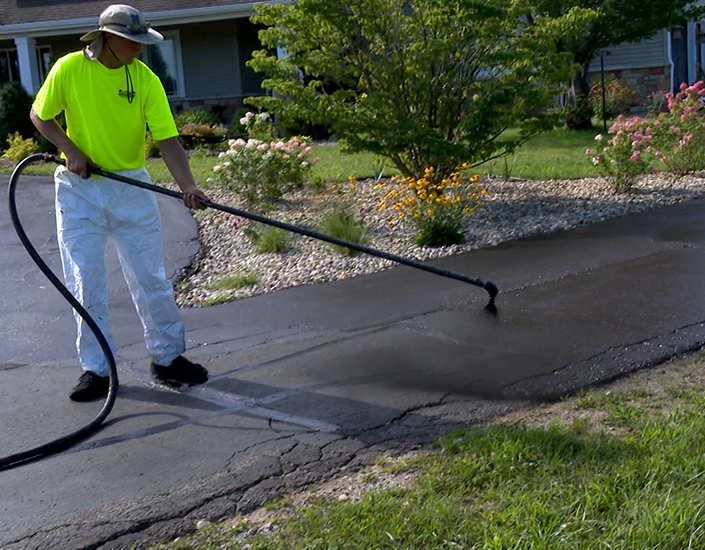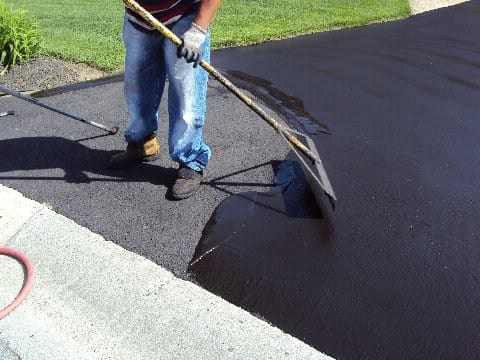Elevate Security and Charm: Angled Parking Area Solutions with Asphalt Sealing
Elevate Security and Charm: Angled Parking Area Solutions with Asphalt Sealing
Blog Article
Warm Mix Asphalt: A Lasting Remedy for Sidewalk
Warm Mix Asphalt (HMA) has emerged as a leading lasting option for pavement options, providing a myriad of environmental benefits and innovative innovations. As the need for green building and construction methods grows, checking out the nuances of HMA's sustainability can give beneficial understandings into the future of sidewalk services.
Ecological Benefits of Warm Mix Asphalt

Additionally, Warm Mix Asphalt helps to minimize urban warmth island impacts. Its dark shade absorbs sunlight, reducing the quantity of warm reflected back into the atmosphere contrasted to lighter-colored pavements. This can lower ambient temperatures in city areas, lowering the demand for a/c and inevitably lowering energy intake.
In enhancement, Warm Mix Asphalt contributes to improved stormwater administration. Its permeable nature allows water to recharge and infiltrate the sidewalk groundwater materials, minimizing drainage and the threat of flooding. These ecological benefits make Warm Mix Asphalt a sustainable option for paving roadways and highways.
Power Performance in HMA Manufacturing
Is power effectiveness a vital element in the production of Hot Mix Asphalt (HMA)? Power plays a considerable duty in the manufacturing of HMA, affecting both cost and ecological sustainability. One essential aspect of power effectiveness in HMA manufacturing is the use of cozy mix asphalt (WMA) modern technologies.
Moreover, developments in plant modern technologies have brought about more energy-efficient HMA manufacturing processes. Modern plants are created with attributes like recycled asphalt pavement (RAP) handling abilities, reliable burner systems, and boosted insulation, all adding to energy financial savings. By enhancing power usage in HMA production, the sector can decrease its carbon impact while preserving high-quality sidewalk materials. Energy effectiveness is, consequently, a crucial consideration in making sure the sustainability of Warm Mix Asphalt manufacturing.
Recyclability of Hot Mix Asphalt
The recyclability of Warm Mix Asphalt (HMA) is a pivotal element of its sustainability and lasting environmental effect. HMA is one of the most recycled materials in the USA, with over 100 million lots of redeemed asphalt sidewalk (RAP) being recycled yearly in new pavement construction. Recycling HMA uses several environmental advantages, such as minimizing the demand for virgin materials, decreasing energy usage during production, and lowering the quantity of waste sent to landfills.
The procedure of reusing HMA involves crushing the existing use this link pavement, squashing it into smaller my response pieces, and mixing it with brand-new accumulation and asphalt binder to produce a recycled mix. On the whole, the recyclability of HMA plays a considerable duty in advertising sustainable methods within the pavement sector.

Long-Term Efficiency of HMA
Asphalt pavements demonstrate sturdiness and durability over a prolonged period, mirroring the long-term efficiency of Warm Mix Asphalt (HMA) The durability of HMA can be credited to its ability to endure heavy web traffic lots, severe climate condition, and the effects of aging. Studies have shown that well-designed and appropriately constructed HMA pavements can last for twenty years or more with routine upkeep. The trick to taking full advantage of the long-term efficiency of HMA hinges on making use of high-quality products, following best techniques in building and construction, and implementing effective maintenance methods. Appropriate drainage, routine assessments, and timely repair services are necessary for protecting the architectural honesty of HMA sidewalks in time. Furthermore, advancements in HMA technology, such as making use of polymer-modified binders and warm mix asphalt, have better boosted the toughness and durability of HMA pavements. By prioritizing high quality building and maintenance techniques, HMA continues to verify itself as a economical and lasting option for long-lasting pavement framework.

HMA: Sturdiness and Sustainability
Demonstrating both sturdiness and sustainability, Hot Mix Asphalt (HMA) has come to be a cornerstone in the building of durable pavement infrastructures - regrading. HMA's durability stems from its capability to withstand heavy lots, severe weather condition conditions, and high website traffic quantities, making it a reputable option for roadways, highways, and airport runways. The composition of HMA, which typically consists of aggregates, binder, and filler, plays a crucial duty in boosting its durability and resistance to tear and wear
Additionally, HMA's sustainability lies in its recyclability and energy-efficient manufacturing process. The capacity to recycle redeemed asphalt pavement (RAP) in new HMA combinations lowers the need for virgin products and reduces the environmental influence of pavement building and upkeep. In addition, the power efficiency of creating HMA depends on its reduced blending temperatures contrasted to various other pavement products, leading to lowered energy Clicking Here usage and greenhouse gas discharges.
Conclusion
In final thought, warm mix asphalt (HMA) provides a lasting option for pavement with its ecologically pleasant features. HMA's recyclability, power performance in manufacturing, and long-term sturdiness make it an eco-friendly choice for roadway building and construction.
HMA is one of the most recycled products in the United States, with over 100 million lots of redeemed asphalt sidewalk (RAP) being reused yearly in new sidewalk construction.The process of reusing HMA entails crushing the existing pavement, crushing it into smaller pieces, and mixing it with brand-new aggregate and asphalt binder to develop a recycled mix.Asphalt pavements demonstrate sturdiness and durability over a prolonged period, mirroring the lasting efficiency of Warm Mix Asphalt (HMA) Additionally, innovations in HMA modern technology, such as the usage of polymer-modified binders and cozy mix asphalt, have even more improved the resilience and durability of HMA pavements. The capability to recycle recovered asphalt sidewalk (RAP) in new HMA combinations decreases the need for virgin products and reduces the environmental effect of sidewalk building and maintenance.
Report this page